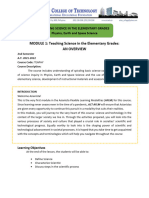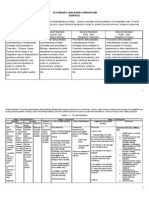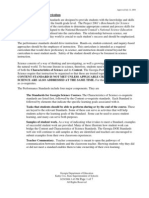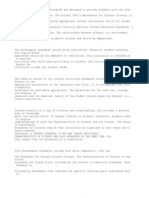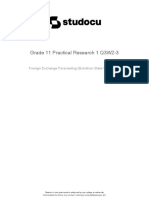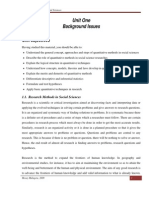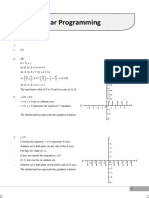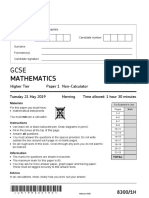Hs Science Standards
Hs Science Standards
Uploaded by
api-271737972Copyright:
Available Formats
Hs Science Standards
Hs Science Standards
Uploaded by
api-271737972Original Title
Copyright
Available Formats
Share this document
Did you find this document useful?
Is this content inappropriate?
Copyright:
Available Formats
Hs Science Standards
Hs Science Standards
Uploaded by
api-271737972Copyright:
Available Formats
SCIENCE STANDARD ARTICULATED BY GRADE LEVEL
HIGH SCHOOL
The Arizona high school science standard was designed to support the instruction and
assessment of students. Science instruction should involve students actively using scientific
processes to understand course content and make connections to real life and related areas of
study. The goal in the development of the standard was to assure that the six strands and five
unifying concepts are interwoven into a fabric of science that represents the true nature of
science. Students have the opportunity to develop both the skills and content knowledge
necessary to be scientifically literate members of the community.
Strands 1, 2, and 3 (Inquiry Process, History and Nature of Science, and Science in Personal and
Social Perspective) contain the processes and connections desired of Arizona students and must,
therefore, be reflected in all science courses. These strands are designed to be explicitly taught
and embedded within each of the content Strands 4, 5, and 6, and are not intended to be taught in
isolation. The processes, skills, and content of the first three strands are designed to umbrella
and complement the content of Life Science, Physical Science, and Earth and Space Science.
At the high school level, Strands 4, 5, and 6 (Life Science, Physical Science, and Earth and Space
Science) contain content area knowledge and skills that are, by nature, course specific. These
strands were written to provide frameworks for complete courses in Life, Physics, Chemistry, and
Earth and Space sciences.
The high school science Arizona Instrument to Measure Standards (AIMS) will be administered as
an end of course test. For each course tested, all performance objectives in Strands 1, 2 and 3
may be included on the assessment. Depending on the course tested, performance objectives
from Strand 4, 5, or 6, will be measured. For example, an end of course AIMS for high school
biology could include performance objectives from Strands 1, 2, 3, and 4. A blueprint of the
Science AIMS will be available following test development.
Italics denote a repetition of a performance objective (learned in an earlier grade) that is to be applied to grade level
content or at a higher level of complexity.
The bulleted items within a performance objective indicate specific content to be taught.
Arizona Department of Education Standards Based Teaching and Learning
Approved 5.24.04
Updated 3.10.05
1
SCIENCE STANDARD ARTICULATED BY GRADE LEVEL
HIGH SCHOOL
Strand 1: Inquiry Process
Inquiry Process establishes the basis for students learning in science. Students use scientific processes:
questioning, planning and conducting investigations, using appropriate tools and techniques to gather data,
thinking critically and logically about relationships between evidence and explanations, and communicating
results.
Concept 1: Observations, Questions, and Hypotheses
Formulate predictions, questions, or hypotheses based on observations. Evaluate appropriate resources.
PO 1. Evaluate scientific information for relevance to a given problem. (See R09-S3C1, R10-S3C1, R11-S3C1, and
R12-S3C1)
PO 2. Develop questions from observations that transition into testable hypotheses.
PO 3. Formulate a testable hypothesis.
PO 4. Predict the outcome of an investigation based on prior evidence, probability, and/or modeling (not guessing or
inferring).
Concept 2: Scientific Testing (Investigating and Modeling)
Design and conduct controlled investigations.
PO 1. Demonstrate safe and ethical procedures (e.g., use and care of technology, materials, organisms) and
behavior in all science inquiry.
PO 2. Identify the resources needed to conduct an investigation.
PO 3. Design an appropriate protocol (written plan of action) for testing a hypothesis:
Identify dependent and independent variables in a controlled investigation.
Determine an appropriate method for data collection (e.g., using balances, thermometers, microscopes,
spectrophotometer, using qualitative changes).
Determine an appropriate method for recording data (e.g., notes, sketches, photographs, videos, journals
(logs), charts, computers/calculators).
PO 4. Conduct a scientific investigation that is based on a research design.
PO 5. Record observations, notes, sketches, questions, and ideas using tools such as journals, charts, graphs, and
computers.
Italics denote a repetition of a performance objective (learned in an earlier grade) that is to be applied to grade level
content or at a higher level of complexity.
The bulleted items within a performance objective indicate specific content to be taught.
Arizona Department of Education Standards Based Teaching and Learning
Approved 5.24.04
Updated 3.10.05
2
SCIENCE STANDARD ARTICULATED BY GRADE LEVEL
HIGH SCHOOL
Concept 3: Analysis, Conclusions, and Refinements
Evaluate experimental design, analyze data to explain results and propose further investigations.
Design models.
PO 1. Interpret data that show a variety of possible relationships between variables, including:
positive relationship
negative relationship
no relationship
PO 2. Evaluate whether investigational data support or do not support the proposed hypothesis.
PO 3. Critique reports of scientific studies (e.g., published papers, student reports).
PO 4. Evaluate the design of an investigation to identify possible sources of procedural error, including:
sample size
trials
controls
analyses
PO 5. Design models (conceptual or physical) of the following to represent "real world" scenarios:
carbon cycle
water cycle
phase change
collisions
PO 6. Use descriptive statistics to analyze data, including:
mean
frequency
range
(See MHS-S2C1-10)
PO 7. Propose further investigations based on the findings of a conducted investigation.
Concept 4: Communication
Communicate results of investigations.
PO 1. For a specific investigation, choose an appropriate method for communicating the results.
(See W09-S3C2-01 and W10-S3C3-01)
PO 2. Produce graphs that communicate data. (See MHS-S2C1-02)
PO 3. Communicate results clearly and logically.
PO 4. Support conclusions with logical scientific arguments.
Italics denote a repetition of a performance objective (learned in an earlier grade) that is to be applied to grade level
content or at a higher level of complexity.
The bulleted items within a performance objective indicate specific content to be taught.
Arizona Department of Education Standards Based Teaching and Learning
Approved 5.24.04
Updated 3.10.05
3
SCIENCE STANDARD ARTICULATED BY GRADE LEVEL
HIGH SCHOOL
Strand 2: History and Nature of Science
Scientific investigation grows from the contributions of many people. History and Nature of Science
emphasizes the importance of the inclusion of historical perspectives and the advances that each new
development brings to technology and human knowledge. This strand focuses on the human aspects of
science and the role that scientists play in the development of various cultures.
Concept 1: History of Science as a Human Endeavor
Identify individual, cultural, and technological contributions to scientific knowledge.
PO 1. Describe how human curiosity and needs have influenced science, impacting the quality of life worldwide.
PO 2. Describe how diverse people and/or cultures, past and present, have made important contributions to
scientific innovations.
PO 3. Analyze how specific changes in science have affected society.
PO 4. Analyze how specific cultural and/or societal issues promote or hinder scientific advancements.
Concept 2: Nature of Scientific Knowledge
Understand how science is a process for generating knowledge.
PO 1. Specify the requirements of a valid, scientific explanation (theory), including that it be:
logical
subject to peer review
public
respectful of rules of evidence
PO 2. Explain the process by which accepted ideas are challenged or extended by scientific innovation.
PO 3. Distinguish between pure and applied science.
PO 4. Describe how scientists continue to investigate and critically analyze aspects of theories.
Italics denote a repetition of a performance objective (learned in an earlier grade) that is to be applied to grade level
content or at a higher level of complexity.
The bulleted items within a performance objective indicate specific content to be taught.
Arizona Department of Education Standards Based Teaching and Learning
Approved 5.24.04
Updated 3.10.05
4
SCIENCE STANDARD ARTICULATED BY GRADE LEVEL
HIGH SCHOOL
Strand 3: Science in Personal and Social Perspectives
Science in Personal and Social Perspectives emphasizes developing the ability to design a solution to a
problem, to understand the relationship between science and technology, and the ways people are
involved in both. Students understand the impact of science and technology on human activity and the
environment. This strand affords students the opportunity to understand their place in the world as living
creatures, consumers, decision makers, problem solvers, managers, and planners.
Concept 1: Changes in Environments
Describe the interactions between human populations, natural hazards, and the environment.
PO 1. Evaluate how the processes of natural ecosystems affect, and are affected by, humans.
PO 2. Describe the environmental effects of the following natural and/or human-caused hazards:
flooding
drought
earthquakes
fires
pollution
extreme weather
PO 3. Assess how human activities (e.g., clear cutting, water management, tree thinning) can affect the potential for
hazards.
PO 4. Evaluate the following factors that affect the quality of the environment:
urban development
smoke
volcanic dust
PO 5. Evaluate the effectiveness of conservation practices and preservation techniques on environmental quality and
biodiversity.
Italics denote a repetition of a performance objective (learned in an earlier grade) that is to be applied to grade level
content or at a higher level of complexity.
The bulleted items within a performance objective indicate specific content to be taught.
Arizona Department of Education Standards Based Teaching and Learning
Approved 5.24.04
Updated 3.10.05
5
SCIENCE STANDARD ARTICULATED BY GRADE LEVEL
HIGH SCHOOL
Concept 2: Science and Technology in Society
Develop viable solutions to a need or problem.
PO 1. Analyze the costs, benefits, and risks of various ways of dealing with the following needs or problems:
various forms of alternative energy
storage of nuclear waste
abandoned mines
greenhouse gases
hazardous wastes
PO 2. Recognize the importance of basing arguments on a thorough understanding of the core concepts and
principles of science and technology.
PO 3. Support a position on a science or technology issue.
PO 4. Analyze the use of renewable and nonrenewable resources in Arizona:
water
land
soil
minerals
air
PO 5. Evaluate methods used to manage natural resources (e.g., reintroduction of wildlife, fire ecology).
Concept 3: Human Population Characteristics
Analyze factors that affect human populations.
PO 1. Analyze social factors that limit the growth of a human population, including:
affluence
education
access to health care
cultural influences
PO 2. Describe biotic (living) and abiotic (nonliving) factors that affect human populations.
PO 3. Predict the effect of a change in a specific factor on a human population.
Italics denote a repetition of a performance objective (learned in an earlier grade) that is to be applied to grade level
content or at a higher level of complexity.
The bulleted items within a performance objective indicate specific content to be taught.
Arizona Department of Education Standards Based Teaching and Learning
Approved 5.24.04
Updated 3.10.05
6
SCIENCE STANDARD ARTICULATED BY GRADE LEVEL
HIGH SCHOOL
Strand 4: Life Science
Life Science expands students biological understanding of life by focusing on the characteristics of living
things, the diversity of life, and how organisms and populations change over time in terms of biological
adaptation and genetics. This understanding includes the relationship of structures to their functions and
life cycles, interrelationships of matter and energy in living organisms, and the interactions of living
organisms with their environment.
Concept 1: The Cell
Understand the role of the cell and cellular processes.
PO 1. Describe the role of energy in cellular growth, development, and repair.
PO 2. Compare the form and function of prokaryotic and eukaryotic cells and their cellular components.
PO 3. Explain the importance of water to cells.
PO 4. Analyze mechanisms of transport of materials (e.g., water, ions, macromolecules) into and out of cells:
passive transport
active transport
PO 5. Describe the purposes and processes of cellular reproduction.
Concept 2: Molecular Basis of Heredity
Understand the molecular basis of heredity and resulting genetic diversity.
PO 1. Analyze the relationships among nucleic acids (DNA, RNA), genes, and chromosomes.
PO 2. Describe the molecular basis of heredity, in viruses and living things, including DNA replication and protein
synthesis.
PO 3. Explain how genotypic variation occurs and results in phenotypic diversity.
PO 4. Describe how meiosis and fertilization maintain genetic variation.
Concept 3: Interdependence of Organisms
Analyze the relationships among various organisms and their environment.
PO 1. Identify the relationships among organisms within populations, communities, ecosystems, and biomes.
PO 2. Describe how organisms are influenced by a particular combination of biotic (living) and abiotic (nonliving)
factors in an environment.
PO 3. Assess how the size and the rate of growth of a population are determined by birth rate, death rate,
immigration, emigration, and carrying capacity of the environment.
Italics denote a repetition of a performance objective (learned in an earlier grade) that is to be applied to grade level
content or at a higher level of complexity.
The bulleted items within a performance objective indicate specific content to be taught.
Arizona Department of Education Standards Based Teaching and Learning
Approved 5.24.04
Updated 3.10.05
7
SCIENCE STANDARD ARTICULATED BY GRADE LEVEL
HIGH SCHOOL
Concept 4: Biological Evolution
Understand the scientific principles and processes involved in biological evolution.
PO 1. Identify the following components of natural selection, which can lead to speciation:
potential for a species to increase its numbers
genetic variability and inheritance of offspring due to mutation and recombination of genes
finite supply of resources required for life
selection by the environment of those offspring better able to survive and produce offspring
PO 2. Explain how genotypic and phenotypic variation can result in adaptations that influence an organisms success
in an environment.
PO 3. Describe how the continuing operation of natural selection underlies a populations ability to adapt to changes
in the environment and leads to biodiversity and the origin of new species.
PO 4. Predict how a change in an environmental factor (e.g., rainfall, habitat loss, non-native species) can affect the
number and diversity of species in an ecosystem.
PO 5. Analyze how patterns in the fossil record, nuclear chemistry, geology, molecular biology, and geographical
distribution give support to the theory of organic evolution through natural selection over billions of years and
the resulting present day biodiversity.
PO 6. Analyze, using a biological classification system (i.e., cladistics, phylogeny, morphology, DNA analysis), the
degree of relatedness among various species.
Concept 5: Matter, Energy, and Organization in Living Systems (Including Human
Systems)
Understand the organization of living systems, and the role of energy within those systems.
PO 1. Compare the processes of photosynthesis and cellular respiration in terms of energy flow, reactants, and
products.
PO 2. Describe the role of organic and inorganic chemicals (e.g., carbohydrates, proteins, lipids, nucleic acids,
water, ATP) important to living things.
PO 3.
Diagram the following biogeochemical cycles in an ecosystem:
water
carbon
nitrogen
PO 4. Diagram the energy flow in an ecosystem through a food chain.
PO 5. Describe the levels of organization of living things from cells, through tissues, organs, organ systems,
organisms, populations, and communities to ecosystems.
Italics denote a repetition of a performance objective (learned in an earlier grade) that is to be applied to grade level
content or at a higher level of complexity.
The bulleted items within a performance objective indicate specific content to be taught.
Arizona Department of Education Standards Based Teaching and Learning
Approved 5.24.04
Updated 3.10.05
8
SCIENCE STANDARD ARTICULATED BY GRADE LEVEL
HIGH SCHOOL
Strand 5: Physical Science
Physical Science affords students the opportunity to increase their understanding of the characteristics of
objects and materials they encounter daily. Students gain an understanding of the nature of matter and
energy, including their forms, the changes they undergo, and their interactions. By studying objects and the
forces that act upon them, students develop an understanding of the fundamental laws of motion,
knowledge of the various ways energy is stored in a system, and the processes by which energy is
transferred between systems and surroundings.
Concept 1: Structure and Properties of Matter
Understand physical, chemical, and atomic properties of matter.
PO 1. Describe substances based on their physical properties.
PO 2. Describe substances based on their chemical properties.
PO 3. Predict properties of elements and compounds using trends of the periodic table (e.g., metals, non-metals,
bonding ionic/covalent).
PO 4. Separate mixtures of substances based on their physical properties.
PO 5. Describe the properties of electric charge and the conservation of electric charge.
PO 6.
Describe the following features and components of the atom:
protons
neutrons
electrons
mass
number and type of particles
structure
organization
PO 7. Describe the historical development of models of the atom.
PO 8. Explain the details of atomic structure (e.g., electron configuration, energy levels, isotopes).
Italics denote a repetition of a performance objective (learned in an earlier grade) that is to be applied to grade level
content or at a higher level of complexity.
The bulleted items within a performance objective indicate specific content to be taught.
Arizona Department of Education Standards Based Teaching and Learning
Approved 5.24.04
Updated 3.10.05
9
SCIENCE STANDARD ARTICULATED BY GRADE LEVEL
HIGH SCHOOL
Concept 2: Motions and Forces
Analyze relationships between forces and motion.
PO 1. Determine the rate of change of a quantity (e.g., rate of erosion, rate of reaction, rate of growth, velocity).
PO 2. Analyze the relationships among position, velocity, acceleration, and time:
graphically
mathematically
PO 3. Explain how Newtons 1st Law applies to objects at rest or moving at constant velocity.
PO 4. Using Newtons 2nd Law of Motion, analyze the relationships among the net force acting on a body, the mass
of the body, and the resulting acceleration:
graphically
mathematically
PO 5. Use Newtons 3rd Law to explain forces as interactions between bodies (e.g., a table pushing up on a vase
that is pushing down on it; an athlete pushing on a basketball as the ball pushes back on her).
PO 6. Analyze the two-dimensional motion of objects by using vectors and their components.
PO 7. Give an example that shows the independence of the horizontal and vertical components of projectile motion.
PO 8. Analyze the general relationships among force, acceleration, and motion for an object undergoing uniform
circular motion.
PO 9. Represent the force conditions required to maintain static equilibrium.
PO 10. Describe the nature and magnitude of frictional forces.
PO 11. Using the Law of Universal Gravitation, predict how the gravitational force will change when the distance
between two masses changes or the mass of one of them changes.
PO 12. Using Coulombs Law, predict how the electrical force will change when the distance between two point
charges changes or the charge of one of them changes.
PO 13. Analyze the impulse required to produce a change in momentum.
PO 14. Quantify interactions between objects to show that the total momentum is conserved in both collision and
recoil situations.
Italics denote a repetition of a performance objective (learned in an earlier grade) that is to be applied to grade level
content or at a higher level of complexity.
The bulleted items within a performance objective indicate specific content to be taught.
Arizona Department of Education Standards Based Teaching and Learning
Approved 5.24.04
Updated 3.10.05
10
SCIENCE STANDARD ARTICULATED BY GRADE LEVEL
HIGH SCHOOL
Concept 3: Conservation of Energy and Increase in Disorder
Understand ways that energy is conserved, stored, and transferred.
PO 1.
Describe the following ways in which energy is stored in a system:
mechanical
electrical
chemical
nuclear
PO 2. Describe various ways in which energy is transferred from one system to another (e.g., mechanical contact,
thermal conduction, electromagnetic radiation.)
PO 3. Recognize that energy is conserved in a closed system.
PO 4. Calculate quantitative relationships associated with the conservation of energy.
PO 5. Analyze the relationship between energy transfer and disorder in the universe (2nd Law of Thermodynamics).
PO 6. Distinguish between heat and temperature.
PO 7. Explain how molecular motion is related to temperature and phase changes.
Italics denote a repetition of a performance objective (learned in an earlier grade) that is to be applied to grade level
content or at a higher level of complexity.
The bulleted items within a performance objective indicate specific content to be taught.
Arizona Department of Education Standards Based Teaching and Learning
Approved 5.24.04
Updated 3.10.05
11
SCIENCE STANDARD ARTICULATED BY GRADE LEVEL
HIGH SCHOOL
Concept 4: Chemical Reactions
Investigate relationships between reactants and products in chemical reactions.
PO 1. Apply the law of conservation of matter to changes in a system.
PO 2. Identify the indicators of chemical change, including formation of a precipitate, evolution of a gas, color
change, absorption or release of heat energy.
PO 3. Represent a chemical reaction by using a balanced equation.
PO 4. Distinguish among the types of bonds (i.e., ionic, covalent, metallic, hydrogen bonding).
PO 5. Describe the mole concept and its relationship to Avogadros number.
PO 6. Solve problems involving such quantities as moles, mass, molecules, volume of a gas, and molarity using the
mole concept and Avogadros number.
PO 7. Predict the properties (e.g., melting point, boiling point, conductivity) of substances based upon bond type.
PO 8. Quantify the relationships between reactants and products in chemical reactions (e.g., stoichiometry,
equilibrium, energy transfers).
PO 9. Predict the products of a chemical reaction using types of reactions (e.g., synthesis, decomposition,
replacement, combustion).
PO 10. Explain the energy transfers within chemical reactions using the law of conservation of energy.
PO 11. Predict the effect of various factors (e.g., temperature, concentration, pressure, catalyst) on the equilibrium
state and on the rates of chemical reaction.
PO 12. Compare the nature, behavior, concentration, and strengths of acids and bases.
PO 13. Determine the transfer of electrons in oxidation/reduction reactions.
Italics denote a repetition of a performance objective (learned in an earlier grade) that is to be applied to grade level
content or at a higher level of complexity.
The bulleted items within a performance objective indicate specific content to be taught.
Arizona Department of Education Standards Based Teaching and Learning
Approved 5.24.04
Updated 3.10.05
12
SCIENCE STANDARD ARTICULATED BY GRADE LEVEL
HIGH SCHOOL
Concept 5: Interactions of Energy and Matter
Understand the interactions of energy and matter.
PO 1. Describe various ways in which matter and energy interact (e.g., photosynthesis, phase change).
PO 2. Describe the following characteristics of waves:
wavelength
frequency
period
amplitude
PO 3. Quantify the relationships among the frequency, wavelength, and the speed of light.
PO 4. Describe the basic assumptions of kinetic molecular theory.
PO 5. Apply kinetic molecular theory to the behavior of matter (e.g., gas laws).
PO 6. Analyze calorimetric measurements in simple systems and the energy involved in changes of state.
PO 7. Explain the relationship between the wavelength of light absorbed or released by an atom or molecule and
the transfer of a discrete amount of energy.
PO 8. Describe the relationship among electric potential, current, and resistance in an ohmic system.
PO 9. Quantify the relationships among electric potential, current, and resistance in an ohmic system.
Italics denote a repetition of a performance objective (learned in an earlier grade) that is to be applied to grade level
content or at a higher level of complexity.
The bulleted items within a performance objective indicate specific content to be taught.
Arizona Department of Education Standards Based Teaching and Learning
Approved 5.24.04
Updated 3.10.05
13
SCIENCE STANDARD ARTICULATED BY GRADE LEVEL
HIGH SCHOOL
Strand 6: Earth and Space Science
Earth and Space Science provides the foundation for students to develop an understanding of the Earth, its
history, composition, and formative processes, and an understanding of the solar system and the universe.
Students study the regularities of the interrelated systems of the natural world. In doing so, they develop
understandings of the basic laws, theories, and models that explain the world (NSES, 1995). By studying
the Earth from both a historical and current time frame, students can make informed decisions about issues
affecting the planet on which they live.
Concept 1: Geochemical Cycles
Analyze the interactions between the Earths structures, atmosphere, and geochemical cycles.
PO 1. Identify ways materials are cycled within the Earth system (i.e., carbon cycle, water cycle, rock cycle).
PO 2. Demonstrate how dynamic processes such as weathering, erosion, sedimentation, metamorphism, and
orogenesis relate to redistribution of materials within the Earth system.
PO 3. Explain how the rock cycle is related to plate tectonics.
PO 4. Demonstrate how the hydrosphere links the biosphere, lithosphere, cryosphere, and atmosphere.
PO 5. Describe factors that impact current and future water quantity and quality including surface, ground, and local
water issues.
PO 6. Analyze methods of reclamation and conservation of water.
PO 7. Explain how the geochemical processes are responsible for the concentration of economically valuable
minerals and ores in Arizona and worldwide.
Italics denote a repetition of a performance objective (learned in an earlier grade) that is to be applied to grade level
content or at a higher level of complexity.
The bulleted items within a performance objective indicate specific content to be taught.
Arizona Department of Education Standards Based Teaching and Learning
Approved 5.24.04
Updated 3.10.05
14
SCIENCE STANDARD ARTICULATED BY GRADE LEVEL
HIGH SCHOOL
Concept 2: Energy in the Earth System (Both Internal and External)
Understand the relationships between the Earths land masses, oceans, and atmosphere.
PO 1. Describe the flow of energy to and from the Earth.
PO 2. Explain the mechanisms of heat transfer (convection, conduction, radiation) among the atmosphere, land
masses, and oceans.
PO 3. Distinguish between weather and climate.
Internal Energy:
PO 4. Demonstrate the relationship between the Earths internal convective heat flow and plate tectonics.
PO 5. Demonstrate the relationships among earthquakes, volcanoes, mountain ranges, mid-oceanic ridges, deep
sea trenches, and tectonic plates.
PO 6. Distinguish among seismic S, P, and surface waves.
PO 7. Analyze the seismic evidence (S and P waves) used to determine the structure of the Earth.
PO 8. Describe how radioactive decay maintains the Earths internal temperature.
External Energy:
PO 9. Explain the effect of heat transfer on climate and weather.
PO 10. Demonstrate the effect of the Earths rotation (i.e., Coriolis effect) on the movement of water and air.
PO 11. Describe the origin, life cycle, and behavior of weather systems (i.e., air mass, front, high and low systems,
pressure gradients).
PO 12. Describe the conditions that cause severe weather (e.g., hurricanes, tornadoes, thunderstorms).
PO 13. Propose appropriate safety measures that can be taken in preparation for severe weather.
PO 14. Analyze how weather is influenced by both natural and artificial Earth features (e.g., mountain ranges,
bodies of water, cities, air pollution).
PO 15. List the factors that determine climate (e.g., altitude, latitude, water bodies, precipitation, prevailing winds,
topography).
PO 16. Explain the causes and/or effects of climate changes over long periods of time (e.g., glaciation,
desertification, solar activity, greenhouse effect).
PO 17. Investigate the effects of acid rain, smoke, volcanic dust, urban development, and greenhouse gases, on
climate change over various periods of time.
Italics denote a repetition of a performance objective (learned in an earlier grade) that is to be applied to grade level
content or at a higher level of complexity.
The bulleted items within a performance objective indicate specific content to be taught.
Arizona Department of Education Standards Based Teaching and Learning
Approved 5.24.04
Updated 3.10.05
15
SCIENCE STANDARD ARTICULATED BY GRADE LEVEL
HIGH SCHOOL
Concept 3: Origin and Evolution of the Earth System
Analyze the factors used to explain the history and evolution of the Earth.
Earth Origin/System:
PO 1. Describe the scientific theory of the origin of the solar system (solar nebular hypothesis).
PO 2. Describe the characteristics, location, and motions of the various kinds of objects in our solar system,
including the Sun, planets, satellites, comets, meteors, and asteroids.
PO 3. Explain the phases of the Moon, eclipses (lunar and solar), and the interaction of the Sun, Moon, and Earth
(tidal effect).
Earth History/Evolution:
PO 4. Interpret a geologic time scale.
PO 5. Distinguish between relative and absolute geologic dating techniques.
PO 6. Investigate scientific theories of how life originated on Earth (high temperature, low oxygen, clay catalyst
model).
PO 7. Describe how life on Earth has influenced the evolution of the Earths systems.
PO 8. Sequence major events in the Earths evolution (e.g., mass extinctions, glacial episodes) using relative and
absolute dating data.
PO 9. Analyze patterns in the fossil record related to the theory of organic evolution.
Concept 4: Origin and Evolution of the Universe
Analyze the factors used to explain the origin and evolution of the universe.
PO 1. Describe the Big Bang Theory as an explanation for the origin of the universe.
PO 2. Describe the fusion process that takes place in stars.
PO 3. Analyze the evolution of various types of stars using the Hertzsprung-Russell (HR) diagram.
PO 4. Compare the evolution (life cycles) of stars of different masses (low and high mass).
PO 5. Explain the formation of the light elements in stars and the heavier elements (what astronomers call metals)
in supernova explosions.
PO 6. Explain the evolution and life cycles of galaxies.
Italics denote a repetition of a performance objective (learned in an earlier grade) that is to be applied to grade level
content or at a higher level of complexity.
The bulleted items within a performance objective indicate specific content to be taught.
Arizona Department of Education Standards Based Teaching and Learning
Approved 5.24.04
Updated 3.10.05
16
You might also like
- Science Standard Articulated by Grade LevelNo ratings yetScience Standard Articulated by Grade Level9 pages
- TX Essential Knowledge Skills Teks ScienceNo ratings yetTX Essential Knowledge Skills Teks Science14 pages
- Secondary National Curriculum - Science 220714No ratings yetSecondary National Curriculum - Science 22071413 pages
- Unit 1: Nature, Aims and Objectives of Teaching ScienceNo ratings yetUnit 1: Nature, Aims and Objectives of Teaching Science22 pages
- Physics - Semester 1: Course-Level SyllabusNo ratings yetPhysics - Semester 1: Course-Level Syllabus3 pages
- Academic Standards For Environment and Ecology PDFNo ratings yetAcademic Standards For Environment and Ecology PDF26 pages
- Science 2007 Programme of Study For Key Stage 3No ratings yetScience 2007 Programme of Study For Key Stage 314 pages
- Taylor Williams Curriculum Presentation 1No ratings yetTaylor Williams Curriculum Presentation 111 pages
- NASAA-Intro To Scientifically Based Research - 0No ratings yetNASAA-Intro To Scientifically Based Research - 033 pages
- Grade 11 Practical Research 1 q3w2 3 PDFNo ratings yetGrade 11 Practical Research 1 q3w2 3 PDF16 pages
- Individual Productivity Differences in Scientific Research: An Econometric Study of The Publications of French PhysicistsNo ratings yetIndividual Productivity Differences in Scientific Research: An Econometric Study of The Publications of French Physicists31 pages
- Science Programmes of Study: Key Stage 4: National Curriculum in EnglandNo ratings yetScience Programmes of Study: Key Stage 4: National Curriculum in England18 pages
- Major in Integrated Science and Engineering, Specifically Aimed at Educators-To-BeNo ratings yetMajor in Integrated Science and Engineering, Specifically Aimed at Educators-To-Be7 pages
- Science GRADES 7-8-9: Program Rationale and Philosophy Program VisionNo ratings yetScience GRADES 7-8-9: Program Rationale and Philosophy Program Vision74 pages
- Human Biology ATAR Year 12 Syllabus For Teaching From January 2024 - PDFNo ratings yetHuman Biology ATAR Year 12 Syllabus For Teaching From January 2024 - PDF28 pages
- GSc 201-Complete Handouts (1-45 Lectures)No ratings yetGSc 201-Complete Handouts (1-45 Lectures)331 pages
- Nature of Science: Course Title Course Code No. of Credit Semester Pre-RequisiteNo ratings yetNature of Science: Course Title Course Code No. of Credit Semester Pre-Requisite18 pages
- Methods of Research Calmorin Chapter 4 Part INo ratings yetMethods of Research Calmorin Chapter 4 Part I39 pages
- Start in The Name of ALLAH ALMIGHTY: "Research Methodologies - Me5703"No ratings yetStart in The Name of ALLAH ALMIGHTY: "Research Methodologies - Me5703"27 pages
- Research Proposal a Simplified Step-by-Step Guide - Revised EditionFrom EverandResearch Proposal a Simplified Step-by-Step Guide - Revised EditionNo ratings yet
- Super Science: Everything You Need to Know About the World Around YouFrom EverandSuper Science: Everything You Need to Know About the World Around YouNo ratings yet
- (05727) - Precast Concrete Technician Study GuideNo ratings yet(05727) - Precast Concrete Technician Study Guide37 pages
- 4020-Ci-Cal-001 - A-Cyanid Adsorption Tank Steel Platform FoundationNo ratings yet4020-Ci-Cal-001 - A-Cyanid Adsorption Tank Steel Platform Foundation26 pages
- Honeywell Sensing Heavy Duty Pressure Px2 Series Datasheet 50069942 I enNo ratings yetHoneywell Sensing Heavy Duty Pressure Px2 Series Datasheet 50069942 I en10 pages
- Precast-Concrete-Sec2-Lifting and Fixing Sockets PDFNo ratings yetPrecast-Concrete-Sec2-Lifting and Fixing Sockets PDF12 pages
- Battery Basics - A Layman's Guide To Batte - BatteryStuff ArticlesNo ratings yetBattery Basics - A Layman's Guide To Batte - BatteryStuff Articles41 pages
- Effect of Disintegrants On Drug Dissolution From Capsules Filled On A Dosator-Type Automatic Capsule-Filling MachineNo ratings yetEffect of Disintegrants On Drug Dissolution From Capsules Filled On A Dosator-Type Automatic Capsule-Filling Machine9 pages
- Class X Mathematics Arithmetic Progressions Presentation Module 1No ratings yetClass X Mathematics Arithmetic Progressions Presentation Module 117 pages
- Commissioning of Large Vacuum Systems: K. ZapfeNo ratings yetCommissioning of Large Vacuum Systems: K. Zapfe10 pages
- Linear Programming: X X 0, y 0 Are Co-Ordinate Axes. X 0, y 0 Represents The Region in 1No ratings yetLinear Programming: X X 0, y 0 Are Co-Ordinate Axes. X 0, y 0 Represents The Region in 14 pages
- Unit 1: Nature, Aims and Objectives of Teaching ScienceUnit 1: Nature, Aims and Objectives of Teaching Science
- Academic Standards For Environment and Ecology PDFAcademic Standards For Environment and Ecology PDF
- Individual Productivity Differences in Scientific Research: An Econometric Study of The Publications of French PhysicistsIndividual Productivity Differences in Scientific Research: An Econometric Study of The Publications of French Physicists
- Science Programmes of Study: Key Stage 4: National Curriculum in EnglandScience Programmes of Study: Key Stage 4: National Curriculum in England
- Major in Integrated Science and Engineering, Specifically Aimed at Educators-To-BeMajor in Integrated Science and Engineering, Specifically Aimed at Educators-To-Be
- Science GRADES 7-8-9: Program Rationale and Philosophy Program VisionScience GRADES 7-8-9: Program Rationale and Philosophy Program Vision
- Human Biology ATAR Year 12 Syllabus For Teaching From January 2024 - PDFHuman Biology ATAR Year 12 Syllabus For Teaching From January 2024 - PDF
- Nature of Science: Course Title Course Code No. of Credit Semester Pre-RequisiteNature of Science: Course Title Course Code No. of Credit Semester Pre-Requisite
- Start in The Name of ALLAH ALMIGHTY: "Research Methodologies - Me5703"Start in The Name of ALLAH ALMIGHTY: "Research Methodologies - Me5703"
- Research Proposal a Simplified Step-by-Step Guide - Revised EditionFrom EverandResearch Proposal a Simplified Step-by-Step Guide - Revised Edition
- Super Science: Everything You Need to Know About the World Around YouFrom EverandSuper Science: Everything You Need to Know About the World Around You
- 4020-Ci-Cal-001 - A-Cyanid Adsorption Tank Steel Platform Foundation4020-Ci-Cal-001 - A-Cyanid Adsorption Tank Steel Platform Foundation
- Honeywell Sensing Heavy Duty Pressure Px2 Series Datasheet 50069942 I enHoneywell Sensing Heavy Duty Pressure Px2 Series Datasheet 50069942 I en
- Precast-Concrete-Sec2-Lifting and Fixing Sockets PDFPrecast-Concrete-Sec2-Lifting and Fixing Sockets PDF
- Battery Basics - A Layman's Guide To Batte - BatteryStuff ArticlesBattery Basics - A Layman's Guide To Batte - BatteryStuff Articles
- Effect of Disintegrants On Drug Dissolution From Capsules Filled On A Dosator-Type Automatic Capsule-Filling MachineEffect of Disintegrants On Drug Dissolution From Capsules Filled On A Dosator-Type Automatic Capsule-Filling Machine
- Class X Mathematics Arithmetic Progressions Presentation Module 1Class X Mathematics Arithmetic Progressions Presentation Module 1
- Linear Programming: X X 0, y 0 Are Co-Ordinate Axes. X 0, y 0 Represents The Region in 1Linear Programming: X X 0, y 0 Are Co-Ordinate Axes. X 0, y 0 Represents The Region in 1











